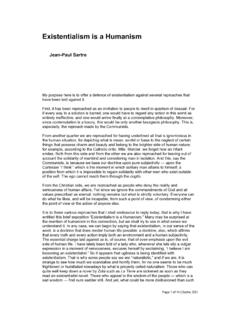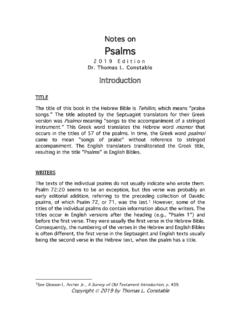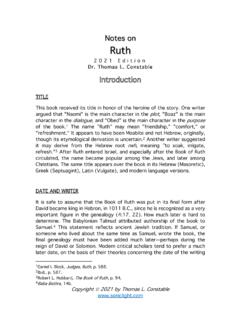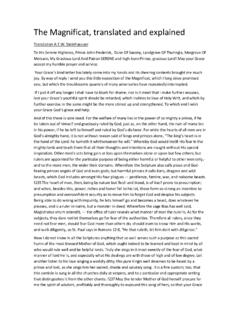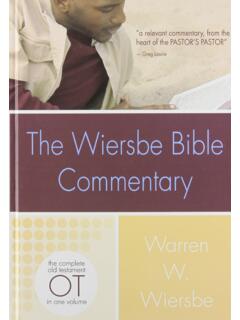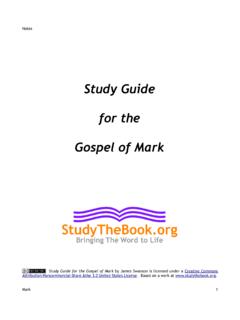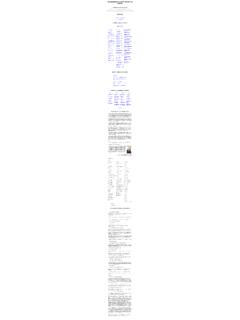Transcription of Old Testament Summaries and Outlines - GraceLife
1 Old Testament Introductions and Analytical Outlines by Charles C. Bing, GraceLife Edition 2013 The introductions and Outlines of the Old and New Testaments were written by Charles C. Bing who earned his and from Dallas Theological Seminary. He founded Burleson Bible Church in Texas which he pastored for 19 years before transitioning to GraceLife Ministries full-time in 2005. He has served as Adjunct Professor of Biblical Studies for LeTourneau University and other theological schools. Dr. Bing helped found the Free Grace Alliance in 2004 and has served as its president. He is active as a speaker for churches and conferences in the United States and abroad and has published a number of books and articles on the gospel, salvation, evangelism, and discipleship. This work represents a portion of the requirements for Dr. Bing s doctoral studies In the Bible exposition department of Dallas Theological Seminary.
2 We hope you find them useful for your studies as others already have. The Introductions give the basic background for each Bible book as a foundation for further study, teaching, or preaching. The Outlines convey the content of the book with great detail and full thoughts so that one sees clearly how the biblical text both flows and divides. These pages may be copied and distributed freely; we only ask that if you quote from this work you give the appropriate credit. For more information or to comment, please contact GraceLife at or write to Box 302, Burleson, TX 76097. We give special thanks to Richard Keller and Lauren Keller for their work in formatting and preparing the manuscripts for web and digital publication. NOTE: To quickly navigate through the PDF document, use the bookmark feature available in the left navigation pane of the PDF viewer. See below for an example.
3 You can also go to the beginning of a Bible book by clicking on the book in the list on the next page. Hyperlink Bookmarks Genesis Song of Solomon Exodus Isaiah Leviticus Jeremiah Numbers Lamentations Deuteronomy Ezekiel Joshua Daniel Judges Hosea Ruth Joel 1 & 2 Samuel Amos 1 & 2 Kings Obadiah 1 & 2 Chronicles Jonah Ezra Micah Nehemiah Nahum Esther Habakkuk Job Zephaniah Psalms Haggai Proverbs Zechariah Ecclesiastes Malachi 1 Summary and Outline of Genesis by Dr. Charles Bing GraceLife Edition 2013 Table of Contents Introduction .. 2 The Author .. 2 The Date .. 2 The Historical Background .. 2 The Purpose .. 3 Argument .. 3 Outline of Genesis .. 7 I. Primeval History: The Creation and the Fall of Man 1:1-11:9 .. 7 A. The creation 1:1-2:3 .. 7 B. The beginnings of man and woman 2:4-25 .. 7 C. The fall of man 3:1-5:32 .. 7 D. The judgment of man 6:1-11:9 .. 7 II. Patriarchal History: The Selection of a People 11:10-50:26.
4 8 A. The life of Abraham 11:10-25:18 .. 8 B. The life of Isaac 25:12-26:35 .. 10 C. The life of Jacob 27:1-36:43 .. 10 D. The life of Joseph 37:1-50:26 .. 12 2 Introduction The Author The question of the authorship of Genesis should be discussed along with the authorship of the rest of the Pentateuch. The traditional view of the Jews and the early church held to Moses as the author of all of the Pentateuch, but this has come under attack in recent centuries. The challenge to Mosaic authorship taken most seriously is known as the "documentary hypothesis". Though the hypothesis takes a number of forms, its basic assertion is that there is evidence in the Pentateuch of multiple authors. Proponents cite different literary styles and different propensities for the use of the names of God, Elohim (E) and Yahweh (J). To this has been added a Priestly Code (P) and a Deuteronomic author (D). Julius Wellhausen is credited with the classic organization of JEDP.
5 According to Wellhausen, the Yahwist wrote about 950 , the Elohist about 850 , the Deuteronomist about 650 , and the Priestly Code was composed about 525 Besides the important testimony of the tradition of the Jews and the early church, there are other reasons to reject the documentary theory and reaffirm Moses as the author of the Pentateuch. First, the Pentateuch itself affirms Moses as its author (Ex. 17:14; 24:4,7; 34:27; Num. 33:1-2; Deut. 31:9). The rest of the Old Testament agrees with this verdict (Josh. 1:7-8; 8:32,34; 22:5; 1 Kings 2:3; 2 Kings 14:6; 21:8; Ezra 6:18; Dan 9:11-13; Mal. 4:4), as well as the New Testament (Matt. 19:8; Mark 12:26; John 5:46-47; 7:19; Rom. 10:5,19). Also, the unity of content and style in the Pentateuch indicates a single author. Furthermore, this author describes details as an eyewitness, such as would not be true of an editor centuries later (Ex. 15:27; Num. 2:1-31; 11:7-8).
6 The author is also familiar with ancient Egyptian names, words, customs, and geography (Gen. 13:10; 16:1-3; 33:18; 41:43) which would be unexpected from a later editor in Canaan, but consistent with Moses training (cf. Acts 7:22). Modern archeological evidence substantiates that literary activity pre-dated Moses. Thus, Moses was not only able to write the Pentateuch, but was able to draw on other ancient documents in his process of writing. It is difficult to imagine who else in all of ancient Israel would have been as qualified and able to compose these five books as Moses. The Date Genesis was certainly written in the last third of Moses' lifetime, after the burning bush incident. The date would then fall between about 1450 to 1410 , but most likely in the latter half of this period. The Historical Background The title "Genesis" is the Greek word meaning "origin, source, generation, and beginning." The first eleven chapters record history's beginning's through many monumental events: the creation of the world, the creation of man, the fall of man, and the judgments of the Flood and of Babel.
7 Throughout the early chapters, a godly line is followed until one man, Abraham, is chosen to begin a special nation for God. Chapter 12 focuses on Abraham and the 3 covenant God made with Him and his chosen descendants. The last chapters of the book (37-50) record how God preserved His special people from adversity. Discussion of the historical setting for Genesis is difficult because this book covers more history than all the other books of the Bible together. The first eleven chapters form a distinct unit and stretch from the creation (c. 4000 or earlier) to the death of Terah (c. 2090 ). The geographical background for chapters 1-11 is the Fertile Crescent. A second distinguishable unit of history is covered by chapters 12-36. This period of 193 years extends from the death of Terah to Joseph's arrival in Egypt (c. 1897 ) and unfolds in the territory of Canaan. A third historical unit covers the ninety-three years of Joseph in Egypt (c.)
8 1897-1804). By its account of origins, Genesis lays the historical, geographical, and religious foundations for every other book in the Bible. The Purpose Genesis is designed to show that God is the sovereign Creator of the universe who created man to rule the world, but because of man's sin this dominion was lost until the promises of restored rule could be realized through God's special chosen race. Therefore, Genesis introduces the beginning of creation, man, man's fall, judgment, and the beginning of redemption through a promise (3:15). Abraham and his family are chosen as those who will mediate this promise to the world (12:2-3). Genesis pursues the history of Abraham and his descendants to show the persistence of God's promise of redemption through the preservation of a special people. The narrative and genealogies, especially as they are arranged around the eleven key structural headings "Now these are the generations of.
9 " (Hebrew toledot; 2:4; 5:1; 6:9; 10:1; 11:10, 27; 25:12, 19; 36:1, 9; 37:2), present history redemptively. God's preservation of a godly line of blessing is traced and contrasted to other ungodly lines in a narrowing fashion so as to show His promised redemption enduring in the early history of man. Argument A simple outline of Genesis begins with the great creative and original events of primeval history (1:1-11:9) and advances to the events and characters of the patriarchal history (11:10-50:26). The redemptive promise of God progresses through the tracing of a godly line as God preserves this special people for Himself. A book of "beginnings" rightly begins in the primeval period with the creation of the universe in six days (1:1-2:3). Creation is an indisputable mark of ownership and the right to sovereign rule. The creation was perfect and thus pronounced "good". Crowning God's creative work was the creation of man and woman, emphasized in more detail by a second account of their beginning (2:4-25).
10 Man was also created perfect, and was designed to represent God's rule over creation in the perfect paradise (1:26-28; 2:8-20). Adversity enters the story with the temptation, seduction, and fall of man (3:1-5:32). Readers are introduced to the enemy of God, Satan, as the serpent. Man's fall depicts the freedom God ordained for His human creations and shows that rebellion against God's Word is the most perverse use of that will. It also establishes Satan as the challenger to God's rule on earth. Man's most critical judgment is death, or separation from the life of the sovereign God. 4 Yet in pronouncing judgment (on the serpent), God declares the protoevangelium in the promise of a Seed from the woman who will restore the rule of God by destruction of Satan (3:15). The expulsion of Adam and Eve from Eden and from the presence of God demonstrates how crucial the need for a restoration between man and God actually is.
